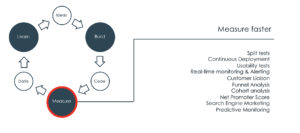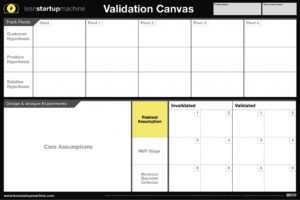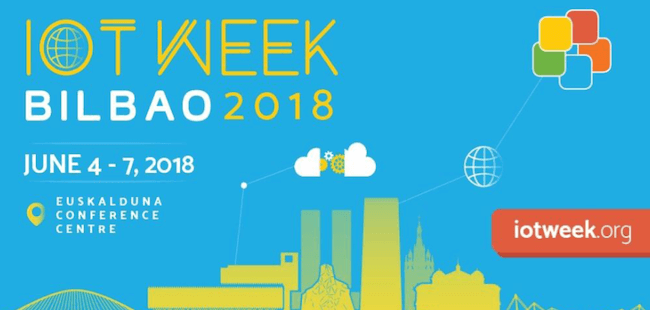The final part of the Learn-Build-Measure cycle is the Measure part. The main idea of this part that it is necessary to compare the real outcome of the product with what was hypothesized – “get out of the building”, test the product and collect data from real life customers. Questions that must be answered in this part include:
- Does the product do what it was hoped it would do?
- Is there sufficient market demand for the product to continue developing it?
- Does the data show that you’ll be able to build a sustainable business around your product or service?

In order to put this theory to the test, the tool Validation Canvas is used. This tool helps keep track of the product development progress and focus on what actually matters for the product developed and the business idea.

On the top of the canvas, the user can track the pivots over time. Bottom left is the area where the experiments can be designed. In this case, the product is redefined as an experiment where the goal is to learn about the customers. The area on the bottom right is designed to measure the progress by learning. The first step in filling out the Validation canvas is defining the hypotheses, which include the customer, the problem and the solution. The customer is defined as a group of people with a common pain. The problem is a specific problem that this customer group has. The solution in this case is not defined since every problem has multiple solutions and defining the solution might make the entrepreneur miss other possible solutions.
After the core hypotheses are defined, the experiments need to be designed. Question “What do I need to learn?” must be asked before developing the experiment. The experiment design starts with defining the core assumptions of the business – something that, if not validated, might cause the business to fail. Having defined a few core assumptions, the riskiest one is picked. Once it is picked, the entrepreneur must ask “What experiment should I build in order to get this learning?”. Possible testing methods might include exploration, which is doing customer interviews, looking for problems, trying to find pain points. This method is followed by the next method, called Pitch. Pitch is asking the customer for some kind of currency (money, email or other) in exchange for solving some kind of problem or for a specific solution. The third method is Concierge – delivering on the pitch with as little technology as possible to as few customers as possible until they’re really excited and happy with the service provided. Each of these methods increase the cost of testing but are necessary to do before continuing building the product. The minimum success criterion defines minimum amount of validation needed to continue working on the project.

Recent Comments